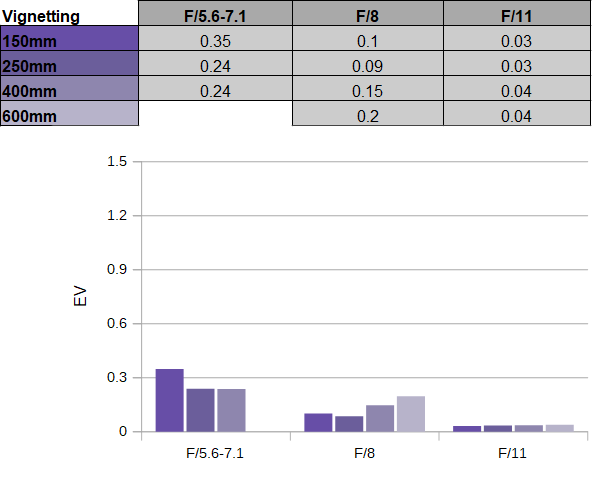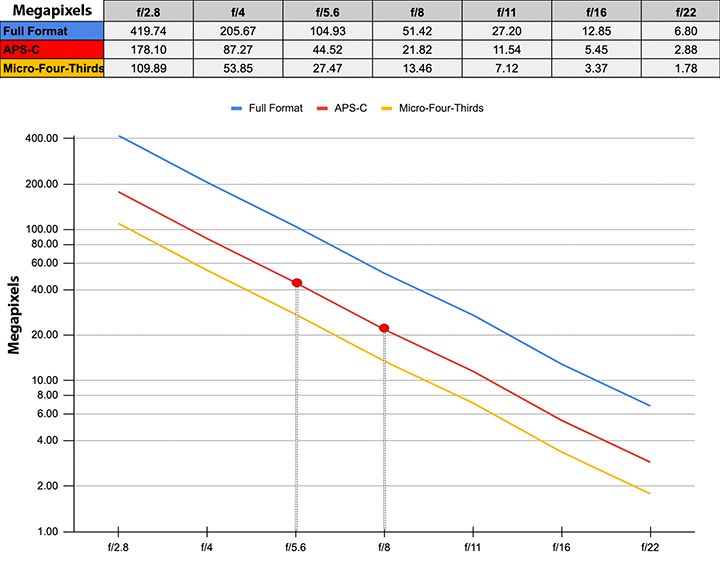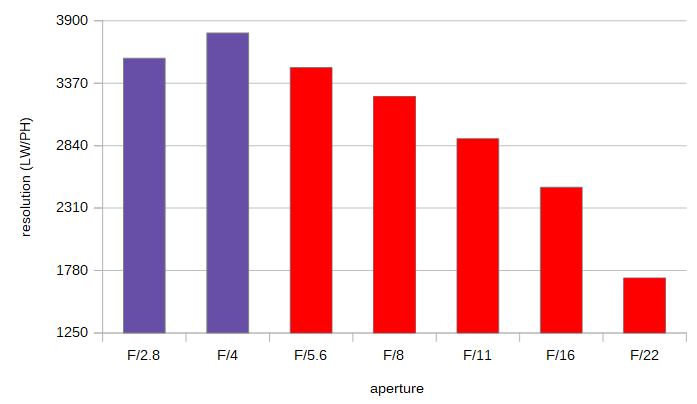|
Fujinon XF 150-600mm f/5.6-8 R LM OIS WR - Review / Test - Analysis |
|
Lens Reviews -
Fujifilm X
|
|
Page 2 of 3

Distortion
Image auto-correction is the de-facto standard today. Activated, you don't have to worry about distortions, as you can see below.
Lenses for mirrorless cameras often produce an insane amount of image distortions in RAW files. However, almost surprisingly, this is not the case with the Fujinon. It produces pincushion distortions, yes, but they are on a very low level with a peak of just 0.8% at 600mm. We actually think that Imatest reported too much there. Visually, we'd estimate it more around the 0.3% mark here.
Vignetting
In standard shooting mode (auto-correction activated), the vignetting is basically absent. However, once again, there are no issues in RAW images either. The chart below shows the RAW figures only.

Diffraction on APS-C cameras
Fujifilm is moving to 40 megapixels sensors and, before discussing the lens resolution, we should have a word about diffraction.
Diffraction is defined as the interference or bending of waves through an aperture. Or in other words - it limits the achievable resolution.
Visible light is usually defined as having wavelengths in the range of 400–700 nanometres (nm). Blue (~450nm) has a smaller wavelength than red (~650nm), as you can see below.
 You can calculate the diffraction limit in megapixels for a given light wavelength and a sensor format. We have prepared the illustration below showing the limits for MFT, APS-C and Full Format. The underlying formulas can be looked up in Wikipedia. Or just google the excellent article over at Luminous Landscapes for a more detailed explanation.
We have marked the range where the Fujinon XF 150-600mm f/5.6-8 R LM OIS WR operates at maximum aperture for a wavelength of 420nm ... which is a rather optimistic starting point (the megapixel limits are much worse for red light).
At f/5.6, the theoretical maximum - for an optimal lens - is about 44 megapixels. At f/8, it's 22 megapixels. Or in other words, assuming that the lens has its maximum resolution at a wide-open aperture, there are basically no issues with Fujifilm's 26 megapixels sensor - if the lens was PERFECT. Perfect lenses do not exist, of course. In contrast, just because of diffraction, you can expect some natural softness on Fujifilm's new 40-megapixel sensors creeping in from somewhere in the middle of the zoom range.
Just to point this out - we aren't telling you this - physics does.
You can calculate the diffraction limit in megapixels for a given light wavelength and a sensor format. We have prepared the illustration below showing the limits for MFT, APS-C and Full Format. The underlying formulas can be looked up in Wikipedia. Or just google the excellent article over at Luminous Landscapes for a more detailed explanation.
We have marked the range where the Fujinon XF 150-600mm f/5.6-8 R LM OIS WR operates at maximum aperture for a wavelength of 420nm ... which is a rather optimistic starting point (the megapixel limits are much worse for red light).
At f/5.6, the theoretical maximum - for an optimal lens - is about 44 megapixels. At f/8, it's 22 megapixels. Or in other words, assuming that the lens has its maximum resolution at a wide-open aperture, there are basically no issues with Fujifilm's 26 megapixels sensor - if the lens was PERFECT. Perfect lenses do not exist, of course. In contrast, just because of diffraction, you can expect some natural softness on Fujifilm's new 40-megapixel sensors creeping in from somewhere in the middle of the zoom range.
Just to point this out - we aren't telling you this - physics does.
 The above is theory, whereas below is the effect of diffraction in one of our lab tests - here: the center performance of the Fujinon XF 80mm f/2.8 LM WR OIS macro.
A macro lens is about as sharp as it gets - being a focus-range corrected, moderately fast prime lens. You can see that the lens performance peaks at f/4. Such a peak at f/2.8 to f/4 is typical for APS-C format lenses on 24-ish megapixel sensors. f/5.6 is affected by diffraction, more so beyond. We have marked the aperture range of the XF 150-600mm f/5.6-8 R LM OIS WR in red to provide the context for the results in the following chapter.
The above is theory, whereas below is the effect of diffraction in one of our lab tests - here: the center performance of the Fujinon XF 80mm f/2.8 LM WR OIS macro.
A macro lens is about as sharp as it gets - being a focus-range corrected, moderately fast prime lens. You can see that the lens performance peaks at f/4. Such a peak at f/2.8 to f/4 is typical for APS-C format lenses on 24-ish megapixel sensors. f/5.6 is affected by diffraction, more so beyond. We have marked the aperture range of the XF 150-600mm f/5.6-8 R LM OIS WR in red to provide the context for the results in the following chapter.

MTF (resolution at 26 megapixel)
I suppose the following may require a deep breath from some readers. There is a reason why we elaborated on diffraction in the previous chapter - even a RED badge Fujinon has to adhere to physics. At 150mm, the dampening effect from diffraction is still very moderate. The lens is very sharp at this setting at f/5.6, and that's across the image frame. Stopping down results in an immediate decrease which becomes more noticeable at f/11.
The more you zoom out, the slower the max aperture - and the more pronounced the impact from diffraction. At 250mm f/6.4, the results are still pretty similar to what we've seen at 150mm. The 400mm results are ever so slightly worse again due to the max aperture of f/7.1 here. At 600mm and f/8, the resolution goes down a little more. The center is still very good, whereas the outer image field is reduced to good quality levels. f/11 should be avoided if possible.
The field curvature is low. The centering quality of the tested sample was very good.
Please note that the MTF results are not directly comparable across the different systems!
Below is a simplified summary of the formal findings. The chart shows line widths per picture height (LW/PH) which can be taken as a measure of sharpness.
If you want to know more about the MTF50 figures, you may check out the corresponding Imatest Explanations

Chromatic Aberrations (CAs)
Once again - lateral CAs are auto-corrected, so you don't have to worry in real life. When looking into the RAW results, the CAs are moderate. The average CA pixel width peaks just beyond 1px at the image borders. Not bad, but, at least in theory, noticeable.

Bokeh
Ultra-long tele lenses tend to have a fairly busy bokeh compared to prime lenses - usually because of strong outlining of the out-of-focus highlights. In critical scenes, this also applies to the Fujinon XF 150-600mm f/5.6-8 R LM OIS WR, as you can see below. The outlining intensifies when stopping down.
 The circular shape of the highlights deteriorates somewhat towards the image borders. However, the effect is comparatively moderate on this lens. As usual, this can be fixed by stopping down ... although you shouldn't do that for the reasons mentioned above.
The quality of the general blur is somewhat harsh in the focus transition zones of both the image background (left below) and foreground (to the right). This isn't unusual for a super-tele zoom lens.
The circular shape of the highlights deteriorates somewhat towards the image borders. However, the effect is comparatively moderate on this lens. As usual, this can be fixed by stopping down ... although you shouldn't do that for the reasons mentioned above.
The quality of the general blur is somewhat harsh in the focus transition zones of both the image background (left below) and foreground (to the right). This isn't unusual for a super-tele zoom lens.

Bokeh Fringing / LoCA
Boheh fringing (also called LoCA) is an axial color fringing effect with purplish halos in front of the focus point and greenish beyond. Due to the slow speed of the Fujinon, this isn't an issue.
|